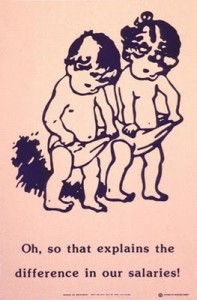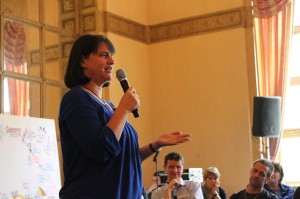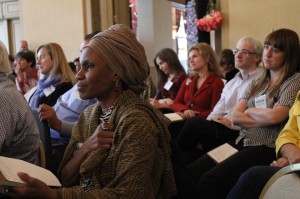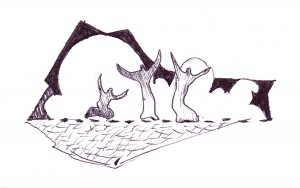[This is a continuation of C4C (2.1)]
While the issue just brought so jarringly to the table had definitely shifted the room’s energy that day, it wasn’t the first time the broad issue of power and equality had come up. I had actually pulled my own “Standing Man” act the day before, though with much less fire and direct personal aim toward our figureheads and organizers.
It happened at the end of the day, when the coordinators made the wise move of inviting
anyone with a particular topic or “burning question” to rise and announce it, so that they and others who shared that interest could find each other over the next two days. I had stood and delivered my three topics on my mind: storytelling, supporting and increasing community-building practitioners on the ground in neighborhoods, and–big scary one!–power and patriarchy within the movement.
This was the first time I’d given voice to my own power/patriarchy concern in any public way among community-building peers. I sat back down—hot, electrified, happy, and half expecting something explosive to happen. But, no walls collapsed… no one smacked me down… no particular hush or buzz filled the room. Others stood and threw their own rich topics out into the room’s bright pond of open, focused faces until, at the facilitator’s word, we dispersed for the day.
And, nothing much else happened after that, apart from a few friends and two new women who came up to me to share gladness that I’d brought up this issue and their commitments to be a part of any discussion group that might form.
Back to Day 2. My first impulse after Standing Man’s outburts was to rush to the “power center” of event speakers and coordinators and see what was happening. What was their reaction?
But, I had to pee. Every conversation I had on the way to do that and back was one of processing what had just happened. En route, I met a woman also keen to see the organizers—to propose that they alter the meeting structure in response to this call from the floor for a “bottom up” conversation rather than “top down” lectures by switching to Open Space for the rest of the day. So, we went together to the huddle of organizers in the corner and posed this question.
With admirable wisdom and grace, organizers Louise Van Rhyn, Charles Holmes, Peter Block and a few others grappled with the situation, then decided to honor the voice of the room as well as the pre-exisitng plan by inviting folks to meet around whatever topic they chose—including the topic and presentation Walter Brueggenham had already prepared.
When this was announced, my friend (and hero) Caitlin Childs took the baton and spoke, offering to host the conversation on power, patriarchy and inequality that Standing Man had brought to the floor.
* * *
The group formed in minutes, and jumped into open dialogue. We began by unpacking our own reactions and reasons for accepting Caitlin’s invitation to this group.
-
Most of us felt relief, support for, and strong resonance with what Standing-Man expressed. We had also been increasingly frustrated with what seemed a starkly obvious contrast between the ideals being espoused and the set-up of the conference, which gave platform and symbolic power to “old white men” as main lecturers, save one woman (Angeles Arrien). Some came because they hadn’t seen that dynamic, but care about equality so wanted to better understand this issue.
-
The imbalance here is mirrored in our movement. Our figureheads are mostly
 old white men. Women, people of color, lower income and other marginalized characteristics enjoy positions of power, notoriety and influence significantly less than white men—despite the fact that they do work that’s just as important and have just as much to contribute.
old white men. Women, people of color, lower income and other marginalized characteristics enjoy positions of power, notoriety and influence significantly less than white men—despite the fact that they do work that’s just as important and have just as much to contribute. -
Alongside frustration at the power imbalance, we feel just as much love, respect and appreciation for these old white men and what they had to share. Many of us wouldn’t be here if it weren’t for their trailblazing efforts. “How much power do these guys have, how much are we giving to them?”, one person pointed out. “What are we waiting for? It’s helpful to have a common story that helps bring together [which they are providing.] They have a name that we trust. If I [hosted this conference,] most of th people in the room wouldn’t come.”
-
That this dialogue is even happening is testament to the “establishment’s” dedication to equality, shared power and bottom-up. In most other gatherings, this topic would never have even made it to the floor, let alone led to a complete overhaul of the meeting plan which now found us here, having this conversation “in the light” of the larger group process, rather than in hushed corners and private rooms.
-
Unlike other movements, the issue is barely ever on the table in these gatherings or in our organizations.
-
This issue is incredibly thorny and personal! We all want to better understand power and privilege in our own lives. One man admitted his own privilege as one of those older white men who is the director of a state agency and his own admitted clueless-ness in handling that. Another woman who was African American called out the fact that “this room is full of white privilege,” and her own frustration that so few people of color were present.
OK, so what? What do we do? Some vague answers came into focus as we talked:
-
“So is it about understanding a common story?” said one man. “We could go around the room right now, all of us have an exile story—a story where we have been left out or felt left out for a variety of reasons, whether it’s color, religion, sexual orientation. If we’re really going to make a difference in our world, I and admit I’m old,white, director of an organization and I sit in that privileged position, but I understand that I have a common story where we’re all been or felt left out. That common piece can bring us together as well. My story of exile is different than yours but common story. We’ve both been left out on some level.”
-
This is about “lifting up” the voices we are not hearing instead of “dragging down” these “old white men” who we all love, appreciate and admire. It’s the same with how we approach our own privilege. One woman asked, “Is the point of the privilege discussion to strip away privilege from my own life so that I’m the least of these?” To which folks replied: “You can’t give that privilege away, it is yours. It’s what you do with it.” “You becoming impoverished does not help people who are in poverty. It’s about being mindful that ‘I have this [power]’ and ‘how am I being in this space?’”
-
The key is to have the conversation. The same woman who’d pointed out the room’s whiteness shared, “I think that there is a conflict inside of many of us around our own privilege and our own power, so it’s easy to resist that kind of conversation. And we might want to talk about things we’re doing, but not addressing how we fit in that structure—so when that comes up, there’s automatic resistance… So I think part of the conversation needs to be telling stories about our conflict, and our privilege… to have the conversation about race, class, what that means in the context of work and community. And we can choose to show up or not show up and to be engaged. For me, it’s more valuable for people to acknowledge where that conflict exists in them, so if we don’t allow that conflict to exist in the floor, and that violence takes shape in us.”
By the end, it felt like we got to a kind of answer. To begin with, it’s key is to have the conversation. We need to tell the stories of exile, exclusion, and inequality and invite them from others. And, we need to keep looking for and helping each other see ways we can restore balance in our own environments, whether that be by calling out imbalance where we see it or using our own privileges to correct them and “lift others up.”
More than a real resolution, this conversation felt to me like a much-needed beginning... and a call to keep it going. I felt relieved and gratified to have finally had this hushed conversation out in the open with a great group of people. Yet, I still had that nagging question of–“so what do we do–here and now, and moving forward—to address the current, actual imbalances that brought us around that circle in the first place?”
Little did I know that, with all this rich learning and exchange, there were still more lessons to come…
* * *
Stay tuned for Part 3… and weigh in:
- What strikes you?
- How does this relate to your world, work, community?




I am eagerly anticipating the next post…..
While I was not at this conference the story you are weaving about the dynamics present in a convening space is incredibly powerful learning. As a practitioner, I am imaging myself in this space and asking “how would I have reacted”, “if I were the graphic recorder, how would I capture this emergent voice?”. Your writing is powerful, I hope you continue to tell this story or jump ahead to where you rest with it now, a few weeks following the event.